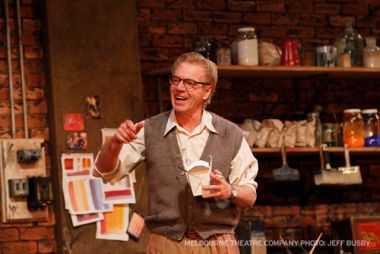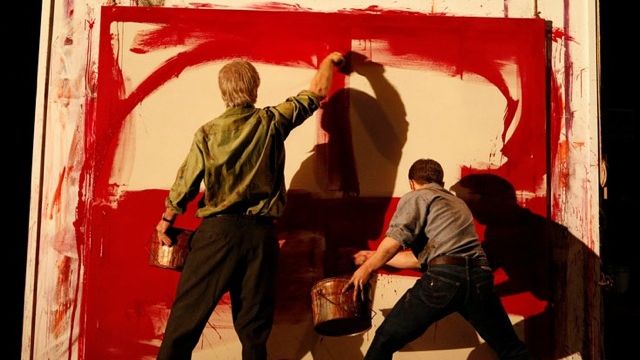Red
Mark Rothko was a mid 20th century painter of colossal ego, lofty ideals and arguably limited talent. He railed against “Art” as decoration and enjoyment, and loathed the pop culture that encouraged art to “sell out” to the highest bidder – and yet he embraced the money it offered. The play covers two years in which he attempts to create the infamous “Red” series of panels for the Four Seasons restaurant in New York.
Lumped together with the abstract expressionists like Jackson Pollack, Franz Kline and Willem de Kooning, Rothko’s style could perhaps more aptly be called “abstract expressionless” stripping back form and imagination to the purity and simplicity of colour and proportion. The panels are red….yet how many shades of red are there (253), and can we see the black within, without getting lost in a maze of Crimson and Cerise, Scarlet and Magenta?
In similar style, but from the opposite end of the spectrum, playwright Logan paints with words. But far from stripping back, Logan uses them to excess in a mellifluous melange of ideas and intellectual discourse. Nothing naturalistic here, nor does Logan intend there to be. It’s an over the top, all-out assault on the mind. The one thing he fails to do, unfortunately, is connect at an emotional level.
 Red is, first and foremost, a dazzling display of intellect through language. Ken, the apprentice, becomes the audience voice, asking the questions we might ask in what would otherwise be a 90 minute monologue, yet rarely challenging, and rarely listened to. Lofty concepts are expressed in overworked clichés without anyone emoting or actually feeling anything. Intelligent text is a welcome change, but the lack of any emotional subtext takes away all joy, much as Rothko’s paintings purport to do.
Red is, first and foremost, a dazzling display of intellect through language. Ken, the apprentice, becomes the audience voice, asking the questions we might ask in what would otherwise be a 90 minute monologue, yet rarely challenging, and rarely listened to. Lofty concepts are expressed in overworked clichés without anyone emoting or actually feeling anything. Intelligent text is a welcome change, but the lack of any emotional subtext takes away all joy, much as Rothko’s paintings purport to do.
The MTC production owes much to the London and New York productions – and why wouldn’t it? Alfred Molina and Eddie Redmayne both gave superlative performances. It’s an actor’s piece, and Colin Friels (as Rothko) is one of our foremost actors. He gives us a Rothko out of step, suffocating under his own ego, yet with a deep fear of his own inadequacy. The louder he proclaims his genius, the more we understand his struggle with the taunting temptation of success and his reverence for pure “Art”. Friels is a good actor, strong and masculine, yet he seems hampered by the endless constrictions of cigarettes and brushes, and uncomfortable in what is, after all, his work space. We never sense that this is the place where he exists, where he can just “be”; but given the emotional limitations of the script it’s hard to say if the problem is with the direction, the performance or the writer’s intent. He is at his best in the silences – and there are a few to give us breathing space. Then, unfettered by the verbiage, we glimpse, for a few seconds at a time, the soul of an artist who knows his mantle of fame is slipping from his shoulders and is desperate to create something which will vindicate his ascetic dedication and win him immortality.
 Andre de Vannay makes a suitably over-awed apprentice, a neophyte at first , growing into an assured disciple of a new world art order with the confidence to rail against his master. Yet, in the latter part of the play, once again the emotional subtext is totally missing. There are opportunities to tap the mine of uncertainty and youth in Ken’s character; to see the painful suppressed emotion in the story of his parents’ brutal murder; to explore his new cockiness as he realises, after two years, that his hero is dressed in the emperor’s new clothes, all in shades of red. They’re not in the current performance, but one senses they could be as this six week run settles in. Again, it’s that sense of connection that’s missing.
Andre de Vannay makes a suitably over-awed apprentice, a neophyte at first , growing into an assured disciple of a new world art order with the confidence to rail against his master. Yet, in the latter part of the play, once again the emotional subtext is totally missing. There are opportunities to tap the mine of uncertainty and youth in Ken’s character; to see the painful suppressed emotion in the story of his parents’ brutal murder; to explore his new cockiness as he realises, after two years, that his hero is dressed in the emperor’s new clothes, all in shades of red. They’re not in the current performance, but one senses they could be as this six week run settles in. Again, it’s that sense of connection that’s missing.
Tsillimidos has blocked the play well, with a constant sense of movement in what could have been a “talking heads” piece; except in the silences, where the stillness is overpowering. However, the much waited for “paint scene”, where master and servant prime the canvas with red, is disappointing. For one thing the canvas seems too small – in the New York production it was so tall that Molina had to climb a ten foot step ladder to paint the top quadrant, and the work itself is anti-climactic after we have already been painted head to foot with a red diatribe.
Tristan Meredith’s evocative soundscape and Matt Scott’s lighting design are both masterful and create a truly believable atmosphere, in a play which tests credibility on all levels. Ultimately the production itself transcends its content.
Images: André de Vanny and Colin Friels in Red. Photographer: Jeff Busby
Coral Drouyn
Subscribe to our E-Newsletter, buy our latest print edition or find a Performing Arts book at Book Nook.

